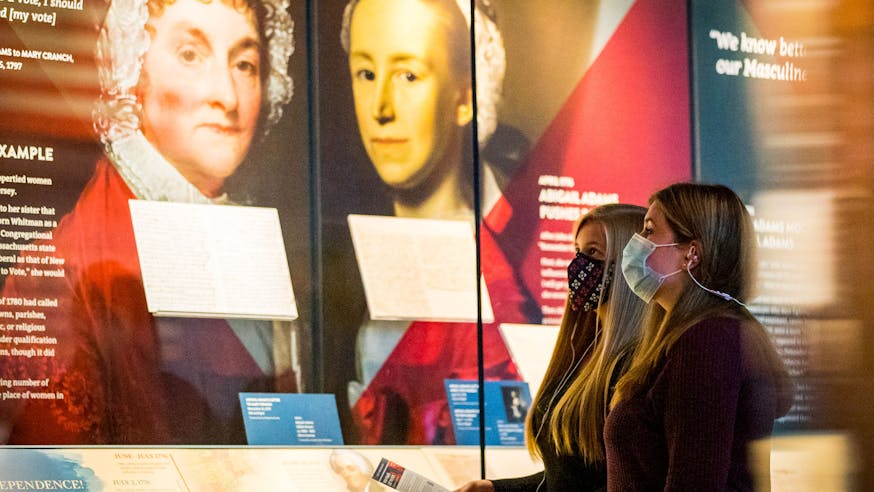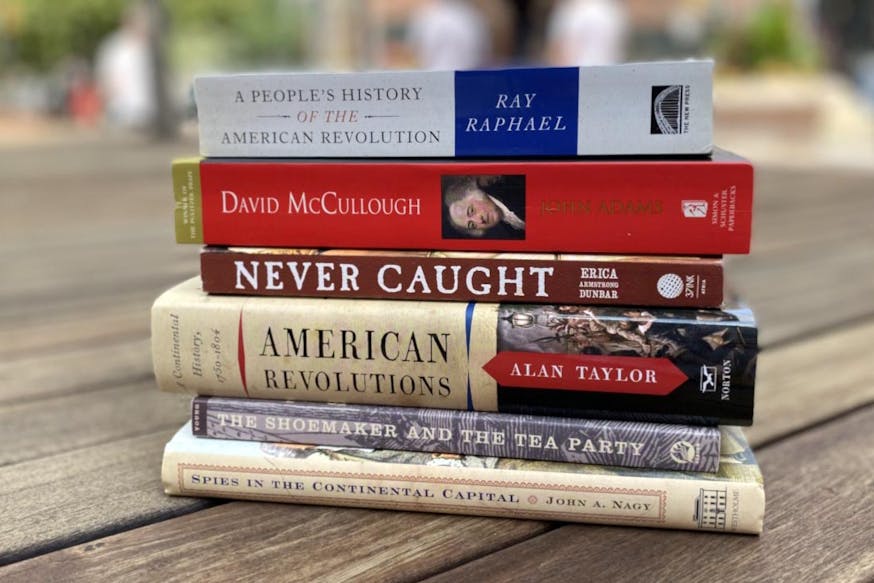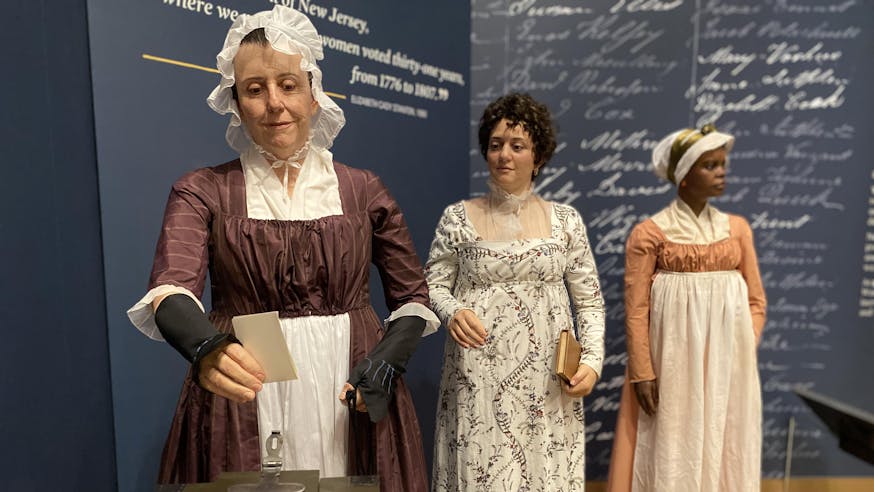Read the Revolution
First Lady of Letters
August 24, 2022
Purchase the book from University of Pennsylvania Press.
August 26 is Women's Equality Day, recognizing the day the 19th Amendment, which granted millions of women the right to vote, was officially certified in 1920. More than 100 years before the 19th Amendment, women were voting in New Jersey from 1776-1807. New Jersey suffragists showed that women’s participation in voting in early New Jersey should not have ended with the loss of the vote in 1807. Rather, those earlier events became a rallying cry decades later when trying to reclaim the right.
But how did women shape and form ideas about equality and civil rights during the Revolutionary War? Judith Sargent Murray (1751-1820), a poet, philosopher, playwright, and early advocate of women's equality whose home in Gloucester, Massachusetts, is now open to the public as a museum, published essays to spark discussion on access to education. In First Lady of Letters: Judith Sargent Murray and the Struggle for Female Independence, historian Sheila L. Skemp delves into some 2,500 personal letters, which were discovered in an archive close to Murray’s burial site in Natchez, Mississippi, to learn more about the push Revolutionary-era women made for equal rights.
Read excerpts from the preface and introduction about the 1779 context for when Murray wrote her most famous essay, “On the Equality of the Sexes,” eventually published in 1790, and how she defined independence in her Massachusetts family home.
Excerpt 1
Despite her criticisms of the way her own society denigrated women, Judith harbored genuine hopes for a more egalitarian future, as she predicted that in time American women would enjoy the education they both needed and deserved; they would meet the “Despot Man” on even ground; they would transcend their “limits and confines”; they would eschew their “showy exteriors,” cultivate their minds, and gain self-confidence. We will, she predicted, learn to “reverence ourselves.” In the meantime, she herself became increasingly conscious of her identity as a woman and more likely to judge every person she met in terms of his or her views of women’s nature.
When she wrote her little manifesto, Judith did not even consider publishing it. She waited until 1790 to revise and submit her essay to the Massachusetts Magazine, calling it “On the Equality of the Sexes” and publishing it under her pen name, “Constantia.” Although she was not yet ready to share her views with a wider audience, by 1779 Judith had begun to develop a comprehensive perspective on women’s rights, a perspective that in its broad outlines she never repudiated. Her essay was in many ways a product of her own experience, especially her resentment of her brother’s superior education and her own “confined” position. “The Sexes” may also have reflected her attitude toward her own marriage. Bored, childless, often at loose ends, Judith may well have come to despise the “adverse fate” that confined her to a meaningless existence that neither challenged nor inspired her. More important, although she never said so directly, the essay was in fact designed primarily for elite women. She did not really believe that her servants resented their lack of education or longed for the day when they had the opportunity to improve their minds. Finally, “The Sexes” was a product of her dreams, as Judith dared to imagine that she, herself, might possess the talent to “enrich the literary world.”
It was no accident that Judith wrote “The Sexes” at a time when her own world was in turmoil. By 1779, the colonies had declared their independence from England and were engaged in a war to make good on that declaration. Indeed, historians have generally assumed that the American Revolution was the catalyst leading Judith to her systematic and thoroughgoing critique of traditional gender constructions. There is little doubt that her demands for women’s equality and her claim that no gender barrier should stand in the way of anyone’s right to the pursuit of happiness were inspired by the language of the War for Independence. The colonial rebellion against monarchy gave Judith arguments she could use to challenge the patriarchal social and cultural conventions that informed her own world. It also led her to think—and to write—in political terms, to view public affairs in the secular world as legitimate subjects for her consideration. Still, it is worth nothing that in “The Sexes,” Judith framed her argument more often by employing spiritual metaphors than she did by embracing the secular rhetoric of independence. Moreover, when the piece did refer—indirectly—to the war effort, it emphasized gender difference rather than the genderless mind. It gave men the role of “Protectors” as it begged them to shield women from “external evils.” Ultimately, Judith admitted that war was less kind to women than it was to men.
At least in the short run, Judith’s understanding of women’s rights was probably more a product of her own decision to embrace the new religion of Universalism than it was a consequence of the War for Independence. Throughout the eighteenth century, the church continued to be the most important institution in most women’s lives. As a woman, Judith had no real role in the colonies’ decision to separate from England. Her decision to leave Gloucester’s First Parish Church, however, was one she made for herself. Her first rebellion was religious, not political. Her first published work was a Universalist catechism. It was Universalism that accorded her a concrete experience with an existence lived on the margins of polite society. And it was Universalism that gave her the courage to cut herself off from inherited traditions and to question many of the values of that society. As historian Linda K. Kerber has observed, in the eighteenth century, to leave the church of one’s birth was a “central psychological experience.” Moreover, when individuals defy expectations in one arena, it sometimes becomes a little easier to defy them in another, to believe that the established wisdom of the ages can be challenged or modified. Religion did not invariably support traditional order. In the right hands, and under the right circumstances, it could be an agent of change.
In the end, it is impossible to disentangle the various threads that combined to create the whole cloth that was the essence of Judith’s developing understanding of gender issues. Because her religious conversion occurred at the same time that America was declaring its independence from England, it is especially difficult to argue that either religion or politics was the formative influence on her view of gender relations. Both were essential. Universalism led Judith to do everything in her power to eradicate perceptions of intellectual differences dividing men and women. The War for Independence led her to recognize that the new nation was becoming increasingly committed to a social construct that emphasized gender difference. Ultimately, however, the “providential view of history” that was so much a part of the psyche of many New England women of the day made it virtually impossible to draw a distinct line between the secular and religious worlds. For Judith Stevens, each experience, each secular or spiritual perspective, acted upon and reinforced the other, until it became in her view at least a seamless whole. Her rebellion against her religious upbringing and her support for the colonial rebellion against English domination were both essential to her quest for women’s rights.
Sign Up
Get biweekly Read the Revolution featured excerpts right to your inbox.
Excerpt 2
Town, congregation, family: these were the overlapping institutions that composed the world of most colonial New Englanders. And it was the family that was the glue that held all other relationships together. In pre-Revolutionary America, the family did not constitute a “private” or isolated retreat from a “public world.” Rather, it was a semipublic institution. It was an integral part of the social matrix, and its members were inextricably tied to their community through a complex web of connections that defined and gave meaning to their lives. Their paths intersected with other inhabitants at church, in the marketplace, and in the neighborly exchanges that characterized the life of the town. Families were also an essential instrument of socialization. They educated and disciplined their own members, imbued successive generations with the values society found desirable, and were an essential link in the “colonial chain of authority.”
If all families were important as social and economic units, all families were not equal. Relationships in colonial society were reciprocal, but, as the structure of the First Parish Church signified, they were also hierarchical. The line dividing successful merchants from the sailors and farmers of the town was becoming increasingly rigid by the time Judith was born. Merchants built more elaborate houses and their possessions were more numerous and more expensive, as their ability to provide their families with material goods that proclaimed their rank to the less fortunate men and women around them grew exponentially. Moreover, as wealthy newcomers to the parish soon discovered, gentility in Gloucester was a moral as well as an economic construct. It was possible to be rich and vulgar, or—especially in the case of women—poor and genteel. Gentility was a product of education and training. It required refinement, the ability to carry oneself gracefully—and to do so with apparent ease.
To be a Sargent in such circumstances was a considerable asset. After the Revolution, Judith sternly warned her niece Sarah Ellery that no American should boast family distinction. Earned merit, not inherited position, was the only measure by which anyone should be judged. In fact, she never forgot just who she was. Whenever Judith looked outward, she knew that her family’s wealth, public service, and lineage determined her place in the social order. As a fourth-generation Sargent, Judith traveled in elite circles. Still, within her family, deference—based on gender and age—was the order of the day.
Sheila L. Skemp, First Lady of Letters: Judith Sargent Murray and the Struggle for Female Independence, (University of Pennsylvania Press, 2011), 6-8, 14.
Read the Revolution is sponsored by The Haverford Trust Company.
Read the Revolution is published biweekly by the Museum of the American Revolution to inspire learning about the history of the American Revolution and its ongoing relevance.
Tags
Learn More

When Women Lost the Vote: A Revolutionary Story
October 2, 2020 - April 25, 2021
Read the Revolution


